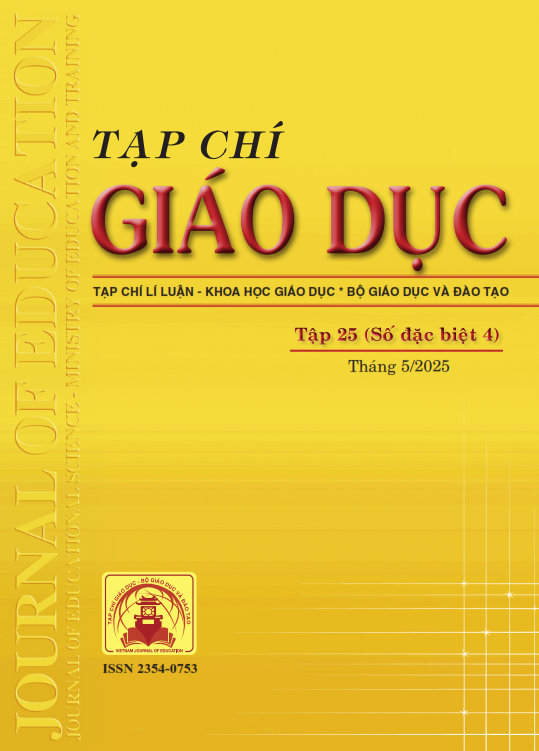Phân tích ảnh hưởng của kĩ năng học tập đến sẵn sàng nghề nghiệp của sinh viên Trường Đại học Công nghiệp Hà Nội thông qua mô hình PLS-SEM
Tóm tắt
In the context of a rapidly changing labor market, the demand for students’ professional skills is increasing, making the development of learning skills essential for improving career readiness. This study, conducted at Hanoi University of Industry, aimed to analyze the impact of learning skills (critical thinking, communication, creative thinking, and teamwork) on students' career readiness. A sample of 395 students was surveyed, and the PLS-SEM model was applied to test the proposed relationships. The findings reveal that all learning skills have a significant and positive effect on career readiness. Based on these results, the study recommends that higher education institutions integrate learning skill development into training programs, balance theory and practice, strengthen partnerships with businesses, and provide career counseling services and soft-skill training activities, in order to better prepare students for the labor market.
Tài liệu tham khảo
Adler, R. B., & Elmhorst, J. M. (2016). Communicating at Work: Strategies for Success in Business and the Professions.
Bandura, A. (1986). Social foundations of thought and action: A social cognitive theory. Prentice Hall.
Bright, J. E., & Pryor, R. G. (2005). The chaos theory of careers: A user's guide. The Career Development Quarterly, 53(4), 291-305. https://doi.org/10.1002/j.2161-0045.2005.tb00660.x
Bryce, T. (1997). Emotional intelligence: Why it can matter more than IQ Daniel Goleman (Bloomsbury publishing plc, London,1995) (Great Britain, 1996), pp. xiv + 352, PB. £7.99. Scottish Educational Review, 29(2), 177-178.
Bulent, A., Hakan, K., & Aydin, B. (2015). An analysis of undergraduates’ study skills. Procedia - Social and Behavioral Sciences, 197, 1355-1362. https://doi.org/10.1016/j.sbspro.2015.07.389
Caballero, C. L., Walker, A., & Fuller-Tyszkiewicz, M. (2011). The work readiness scale (WRS): Developing a measure to assess work readiness in college graduates. Journal of Teaching and Learning for Graduate Employability, 2(1), 41-54. https://doi.org/10.21153/jtlge2011vol2no1art552
Dooly, M., & Sadler, R. (2013). Filling in the gaps: Linking theory and practice through telecollaboration in teacher education. ReCALL, 25(1), 4-29. https://doi.org/10.1017/s0958344012000237
Dreyfus, S. E., & Dreyfus, H. L. (1980). A five-stage model of the mental activities involved in directed skill acquisition. https://doi.org/10.21236/ada084551
Facione, N. C., Facione, P. A., & Sanchez, C. A. (1994). Critical thinking disposition as a measure of competent clinical judgment: The development of the California critical thinking disposition inventory. Journal of Nursing Education, 33(8), 345-350. https://doi.org/10.3928/0148-4834-19941001-05
Facione, P. (1992). A letter from Peter Facione. Inquiry: Critical Thinking Across the Disciplines, 9(1), 12-13. https://doi.org/10.5840/inquiryctnews19929169
Fornell, C., & Larcker, D. F. (1981). Evaluating Structural Equation Models with Unobservable Variables and Measurement Error. Journal of Marketing Research, 18(1), 39-50.
Fisher, R. A. (1962). The Simultaneous Distribution of Correlation Coefficients. Sankhyā: The Indian Journal of Statistics, Series A (1961-2002), 24(1), 1-8. http://www.jstor.org/stable/25049187
Gall, M. D. (1990). Tools for learning: A guide to teaching study skills.
Gettinger, M., & Seibert, J. K. (2002). Contributions of study skills to academic competence. School Psychology Review, 31(3), 350-365. https://doi.org/10.1080/02796015.2002.12086160
Gilchrest, C., Srnka, K., Gardner, L., Frye, W. S., Katzenstein, J., & Feldman, M. (2022). Trainee perspectives on internship and fellowship training experiences in pediatric health service psychology during a global pandemic. Evidence-Based Practice in Child and Adolescent Mental Health, 7(3), 363-373. https://doi.org/10.1080/23794925.2022.2081947
Hair, J. F., Anderson, R. E., Babin, B. J., & Black, W. C. (2017). Multivariate Data Analysis (7th ed.). Pearson.
Hermawan, S., & Hariyanto, W. (2022). Buku ajar Metode Penelitian Bisnis (Kuantitatif Dan Kualitatif). https://doi.org/10.21070/2022/978-623-464-047-2
Jansen, E. P., & Suhre, C. J. (2010). The effect of secondary school study skills preparation on first‐year university achievement. Educational Studies, 36(5), 569-580. https://doi.org/10.1080/03055691003729070
Johnson, D. W., & Johnson, R. T. (2014). Cooperative Learning in 21st Century.[Aprendizaje cooperativo en el siglo XXI]. Anales de Psicología/Annals of Psychology, 30(3), 841-851.
Nunnally, J. C., & Bernstein, I. H. (1994). Psychometric Theory (3rd ed.). McGraw-Hill.
Paul, R., & Elder, L. (2019). The nature and functions of critical & creative thinking. Rowman & Littlefield.
Purdie, N., & Hattie, J. (1999). The relationship between study skills and learning outcomes: A meta-analysis. Australian Journal of Education, 43(1), 72-86. https://doi.org/10.1177/000494419904300106
Runco, M. A., & Jaeger, G. J. (2012). The Standard Definition of Creativity. Creativity Research Journal.
Scott, M. D., McCroskey, J. C., & Sheahan, M. E. (1978). Measuring communication apprehension. Journal of Communication, 28(1), 104-111. https://doi.org/10.1111/j.1460-2466.1978.tb01571.x
Sternberg, R. J., & Sternberg, K. (2011). Cognitive psychology. Wadsworth Publishing Company.
Super, D. E. (1975). Career education and career guidance for the life span and for life roles. Journal of Career Development, 2(2), 27-42. https://doi.org/10.1177/089484537500200204
Torrance, E. P. (1972). Predictive validity of the Torrance tests of creative thinking*. The Journal of Creative Behavior, 6(4), 236-262. https://doi.org/10.1002/j.2162-6057.1972.tb00936.x
Wagner, P., Schober, B., & Spiel, C. (2008). Time students spend working at home for school. Learning and Instruction, 18(4), 309-320. https://doi.org/10.1016/j.learninstruc.2007.03.002
Zhang, D., Cuthbert, L., & Ketteridge, S. (2011). Work in progress — Effective teaching of technical teamwork to large cohorts of engineering students in China. 2011 Frontiers in Education Conference (FIE), F1C1-F1C-3. https://doi.org/10.1109/fie.2011.6142710
Đã Xuất bản
Cách trích dẫn
Số
Chuyên mục
Giấy phép

Tác phẩm này được cấp phép theo Ghi nhận tác giả của Creative Commons Giấy phép quốc tế 4.0 .












